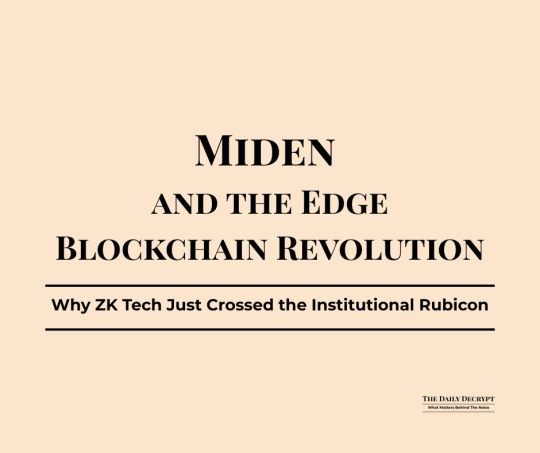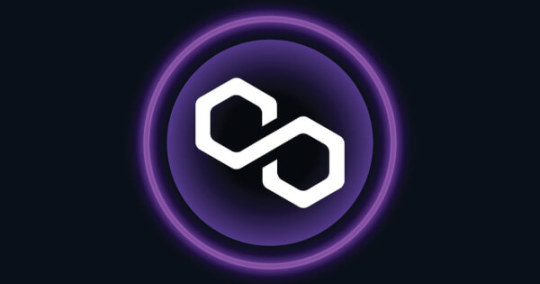#AggLayer
Explore tagged Tumblr posts
Text

🚨 The Web3 Earning Revolution Has Arrived!
Get In Before It Goes Vertical The Next Earning Beast Is Here.
Web3 is evolving — and so is the way we POLNetwork earn.
No more complex DeFi setups. No more waiting on staking rewards. No more gambling on tokens that pump.
POL Network introduces a smarter way to earn crypto — built on blockchain, powered by people.
No renewals. No subscriptions. You earn. The system runs itself.
We’re just getting started…
🔗 AI tools, payments, and real-world utilities are coming next.
This isn’t just a referral system. It’s the foundation of Web3 Income 2.0 — where tech meets people, and opportunity meets automation.
The network is POLNetwork gaining speed. The earning curve is ready to explode.
⏳ You’re still early. Don’t wait.
Be the reason others join. Be early. Be positioned. Be ready.
⚡️ POL Network is going vertical. Join before the breakout hits.
🔗 https://linktr.ee/polnetwork
#Polygon#PolygonLabs#BuildOnPolygon#PoweredByPolygon#PolygonEcosystem#PolygonNetwork#POLToken#POLUpgrade#POLChain#⚙️ Tech & Scaling Focus:#PolygonCDK#zkEVM#PolygonzkEVM#Layer2#ScalingEthereum#100KTPS#Gigagas#BlockchainScaling#AggLayer#ModularBlockchain#FastFinality#Web3Infrastructure#💸 Payments#RWA & DeFi:#DeFiOnPolygon#StablecoinsOnPolygon#PolygonPayments#RWAsOnPolygon#TokenizedAssets#Web3Banking
0 notes
Text
MATIC Migration: POL + AggLayer = Prosperity
The largest mass media convince us that absolutely nothing interesting happened on September 4, 2024. Only here and there, on the last pages of famous publications, boring news flashed about some update in the Polygon network... How tedious, let's scroll through it! This is for nerds. It is much more interesting to get stuck in TikTok or tap Hamster Kombat.
However, there is nothing surprising: people are used to not noticing significant events that affect their own lives. The dinosaurs of the late Mesozoic also indifferently chewed grass or a smaller brother, watching the combustion of a giant asteroid entering the earth's atmosphere.
Nevertheless, the importance of this technological solution cannot be overestimated. So, on September 4, the MATIC token was converted into POL. The goal is grandiose: to create a cross-chain interoperability protocol called AggLayer that will bridge the gap between first-layer blockchains, like Solana and Ethereum.
The token migration is a major step in the implementation of the new Polygon 2.0 standard. It will provide virtually unlimited scalability and unite all the key blockchains into a single whole. Hopefully, we will soon be able to send tokens to any blockchain as easily as transferring money between different banks.

0 notes
Text

AggLayer aims to create an interconnected web of sovereign #blockchains that interoperate securely and feel like a single chain. It combines the advantages of both monolithic and modular systems through the implementation of zero-knowledge technology.
#blockchain#crypto#polygon#agglayer#polygonblockchain#blockchain rollups#layer 2#scalability#ethereum#evm
0 notes
Text
Revolutionizing Efficiency: Polygon's Type-1 zkEVM Paves the Way for Cost-Effective Blockchain Solutions
Polygon has raised the bar in blockchain technology with the release of the Type-1 upgrade to its zkEVM prover, introducing a host of groundbreaking features. Developed in collaboration with Toposware, this upgrade represents a significant leap forward, allowing the generation of proofs for any EVM chain, from sidechains to optimistic rollups and the Ethereum mainnet itself.
The Type-1 prover's Ethereum equivalence is a standout feature, preserving all of Ethereum's execution logic and enabling any EVM chain to seamlessly transition to a ZK Layer 2 without the need for forking or modification. This open-source solution, available for immediate use, adds to the accessibility and innovation of Polygon's offerings.
Cost-effectiveness takes center stage with the Type-1 prover, as the average per-transaction cost for proving Ethereum mainnet blocks falls between $0.002 and $0.003. The integration with AggLayer is a pivotal component, providing a smooth transition to ZK Layer 2 for EVM chains and offering access to the shared state, liquidity, and user base of the Polygon ecosystem.
Polygon CDK, a modular toolkit for creating ZK Layer 2s, enables projects to leverage the Type-1 prover configuration. Notable projects such as Immutable zkEVM, Manta Network, and Canto Public are set to benefit from lower costs and enhanced user experiences by connecting to AggLayer.
Looking ahead, Polygon's ambitious roadmap includes further performance optimizations and the introduction of a Type-2 mode. Anticipated releases like Plonky3 and enhancements to zkEVM promise a substantial 30 to 50X decrease in costs within the next year. This upgrade signifies a monumental advancement in blockchain technology, emphasizing Polygon's commitment to fostering interoperability and efficiency within the blockchain ecosystem. As of the latest update, Polygon (MATIC) showcases a 1.36% growth in the last 24 hours, valued at $0.8428.
0 notes
Text
DeFi-native Chain Katana Goes Live with Real Yield Design and Crosschain Support
Katana, a new DeFi-first layer-2 blockchain, went live on mainnet with over $200 million in pre-deposits just weeks after its public reveal, making it one of the most capitalized debuts of any layer-2 network this year, according to a Monday announcement. Developed by the Katana Foundation, the Polygon Agglayer Breakout Program graduate is designed to support high-yield decentralized finance…
0 notes
Text
Will POL Rise From The Ashes?
Polygon plans to pivot, focusing on the PoS and AggLayer with leadership from CEO Sandeep Nailwal. POL has been dragging lower as Ethereum layer-2 solutions like Base and Arbitrum increase in TVL. Ethereum is inherently less scalable, making it impossible to run a Facebook-like dApp without users incurring thousands in fees and congesting the network. Polygon, an Ethereum sidechain, recognized…
0 notes
Text
Polygon unveils 'Gigagas' roadmap to reach 100,000 TPS
Polygon has laid out an ambitious scaling roadmap to reach 100,000 transactions per second (TPS), beginning with a July upgrade that will bring the network to 1,000 TPS. The roadmap comes a day after Polygon announced a governance revamp and shift in focus to Agglayer. Dubbed the “Gigagas” roadmap, the initiative is focused on making Polygon the go-to blockchain for real-world financial…
0 notes
Text
Polygon يكشف عن خريطة الطريق "Gigagas" للوصول إلى 100000 TPS
وضعت Polygon خريطة طريق تحجيم طموحة للوصول إلى 100000 معاملة في الثانية (TPS) ، بدءًا من ترقية يوليو تصل الشبكة إلى 1000 TPS.تأتي خارطة الطريق بعد يوم من إعلان Polygon عن تجديد الحوكمة والتحول في التركيز إلى Agglayer.أطلق عليه اسم "أزعج"خارطة الطريق ، تركز المبادرة على جعل المضلع عبارة عن policchain للتقديم للتطبيقات المالية في العالم الحقيقي. وهي تتوج بخطة طويلة الأجل لسلطة المدفوعات العالمية والأصول المميزة.ستقدم ترقية Bhilai في يوليو أكثر من 1000 TPS ، وتقلل من نهائيات المعاملة إلى حوالي 5 ثوانٍ ، وتثبيت رسوم الغاز أقل من 0.001 دولار لكل معاملة دون زيادة متطلبات المدقق.في تطوير منفصل ، أصبح الرمز الأصلي للشبكة متاحًا على Solana (SOL) عبر جسر Wormhole في 12 يونيو.نهائية فورية بحلول نهاية العامبحلول نهاية هذا العام ، تتوقع Polygon أن تتراوح بين 5000 TPS باستخدام نموذج منتج جديد للمنتج (VEBLOP) الذي ينتخب مدققًا جديدًا والذي يبسط الإنتاج مع التحقق من صحة عديمة الجنسية وبنية قادة واحدة.يزيل هذا النهج خطر إعادة تنظيم السلسلة من خلال ضمان نهائيات واحدة ، وهو شرط رئيسي للمؤسسات والتطبيقات المالية التي تتطلب التنفيذ المتوقع.وقال Polygon إن معيار 5000 TPS قد تم تحقيقه بالفعل في بيئة DevNet ، مع اقتراحات تقنية (PIP-64 وغيرها) تحدد المسار إلى Mainnet.إلى جانب هذه الترقية ، ستتكامل Polygon أيضًا مع Agglayer ، وهي طبقة قابلية للتشغيل البيني المتعدد التي يتم تشغيلها بواسطة Pol Staking والتي تسمح بحركة سيولة سلسة عبر السلاسل.نحو 100000 TPS وما بعدهفي عام 2026 وما بعده ، يتمثل هدف Polygon في تجاوز 100000 TPS من خلال التحسين المستمر لشبكة المدقق الخاصة بها وتكامل أعمق مع Agglayer.كما سيركز على التحجيم لحالات الاستخدام ذات الحجم الكبير مثل مدفوعات البيع بالتجزئة ، والمعاملات الدقيقة التي تحركها الذكاء الاصطناعي ، والأسواق المالية الرمزية. تهدف الشبكة إلى مطابقة موثوقية وسرعة أنظمة الدفع التقليدية مع الحفاظ على اللامركزية.يحتل polygon بالفعل المرتبة الأولى بين السلاسل العليا في نشاط Stablecoin و RWA ، حيث بلغت حجم أكثر من 134 مليار دولار في حجم Stablecoin في أبريل ومئات الملايين من RWAs المؤسسية التي تنشرها شركات مثل Apollo و BlackRock.ومع ذلك ، قال فريق Polygon إن السلسلة تحتاج إلى توسيع نطاق "ترتيب أعلى" لدعم تريليونات في القيمة على السلسلة.تشير خريطة طريق Gigagas إلى تحول من التحجيم النظري إلى التنفيذ في العالم الحقيقي ويوضع المضلع كطبقة بنية تحتية عالية الإنتاجية للموجة التالية من تبني blockchain.المذكورة في هذه المقالة
0 notes
Text
Polygon 联合创始人 Sandeep Nailwal 被任命为基金会 CEO
深潮 TechFlow 消息,6 月 11 日,据彭博社报道,Polygon 联合创始人 Sandeep Nailwal 被任命为基金会 CEO,负责 Polygon 的开发和增长方面监督。在短期内,Polygon 将专注于扩展 AggLayer 应用。
0 notes
Text
Polygon Co-Founder Mihailo Bjelic Steps Down, Plans to Stay in Crypto Space
Key Takeaways: Mihailo Bjelic has stepped down from the Polygon Foundation but signaled he will stay active in the crypto space. His departure follows two other high-profile exits, though Polygon continues pushing forward with new initiatives like the Agglayer Breakout Program. Industry figures praised Bjelic’s contributions, highlighting his key role in shaping Polygon’s growth and…
0 notes
Text
TAC Hosts Takeover At Topgolf Dubai, Attracting Over 1,600 Companies In Collaboration With Agglayer
Blockchain solution designed specifically for EVM decentralized applications (dApps) seeking to access the TON and Telegram ecosystems—reaching a user base of over one billion—TAC has reported strong attendance and engagement at its TOKEN2049 Dubai side event, “TAC Takeover: Sunset Swings with Agglayer,” held on April 30th at Topgolf Dubai. The event was presented in collaboration with
Read More: You won't believe what happens next... Click here!
1 note
·
View note
Link
Polygon Founder Envisions a Future of Thousands of Niche Blockchains Sandeep Nailwal, the visionary founder of Polygon, predicts a future where the blockchain landscape is dominated by thousands of custom-built, application-specific blockchains ( #Blockchain #Crypto
0 notes
Text
Miden and the Edge Blockchain Revolution: Why ZK Tech Just Crossed the Institutional Rubicon

In the pantheon of blockchain buzzwords, few shine as brightly—or as vaguely—as “scalability” and “privacy.” For over a decade, blockchains have promised both. Few have delivered. But with Miden’s $25 million funding round led by a16z Crypto, we may have finally arrived at a new chapter—one where these aspirations are not just marketing slogans but actual architecture.
Miden, a zero-knowledge (ZK) proof-powered blockchain spun out of Polygon Labs, is pioneering a new model it calls “edge execution.” The premise? Shift transaction processing from congested centralized nodes to the very edges of the network—end users’ devices—while embedding privacy as a feature, not a compromise. If that sounds revolutionary, that’s because it is.
And Wall Street is taking notice.
The ZK Moment, Institutionalized
ZK technology has been hyped for years as the secret weapon of crypto. The ability to verify transactions without revealing data solves a gaping flaw in current blockchains: transparency without discretion. For retail users, that might be acceptable. For Apple, JPMorgan, or Pfizer, it’s a dealbreaker.
Enter Miden.
With a16z Crypto, Hack VC, and 1kx leading the round—and support from high-profile angels like MakerDAO’s Rune Christensen and EigenLayer’s Sreeram Kannan—Miden isn’t just another L1. It’s a signal. Big capital is betting that institutions are finally ready for Web3, and they need a purpose-built blockchain stack to get there.
The thesis is bold: existing chains—Ethereum, Solana, Aptos, Sui—are fundamentally constrained by their architecture. They either scale poorly, compromise on privacy, or sacrifice decentralization to boost throughput. Miden aims to sidestep all three landmines through a simple but powerful idea: push computation to the user’s device, not the chain.
What Is Edge Execution?
Think of edge execution as a local-first blockchain. Rather than funneling all transactions through a global, congested network, Miden pushes smart contract execution and state management to user devices. This minimizes bottlenecks, preserves privacy, and drastically improves performance.
Bobbin Threadbare, Miden co-founder and ex-Meta engineer, put it clearly: “It allows blockchains to scale without relying on supernodes or sacrificing decentralization, while making privacy a built-in feature instead of an afterthought.”
In a world increasingly concerned with data leaks, regulatory scrutiny, and AI-driven surveillance, this design choice feels prescient.
The Privacy-Performance Tradeoff Is Dead
Historically, adding privacy to blockchain systems came at a steep cost: lower throughput, higher gas fees, and more complexity. Miden is designed to flip that assumption.
By default, it enables both public and private transactions. Want to hide your payment details while maintaining regulatory auditability? Done. Need to batch-settle thousands of microtransactions with programmable confidentiality? Also done. This is the kind of functionality institutions have quietly been demanding—but until now, nobody was able to deliver.
As co-founder Azeem Khan explained, Miden could enable corporate use cases where confidentiality is not optional. “Every time Apple pays a supplier, it’s market-sensitive information,” he said. “If that’s on a public chain, it invites speculation, manipulation, even chaos.”
This is the kind of high-trust, high-stakes problem crypto has failed to address—until now.
Independence Is Not Just Optics
While Miden was incubated by Polygon Labs, its recent spinout is a smart move. Independence allows it to attract capital, partnerships, and dev talent without being overshadowed by Polygon’s broader roadmap. Still, it remains part of the Polygon AggLayer ecosystem—a growing web of modular, cross-chain liquidity hubs.
This hybrid structure gives Miden the best of both worlds: independence and integration. Its upcoming airdrop, which will distribute 10% of its native token to POL tokenholders and stakers, reinforces its roots in the Polygon ecosystem while establishing its own native incentives.
As Sandeep Nailwal, co-founder of Polygon Labs, said: “Miden is not just an upgrade. It’s the blueprint for the final form of blockchain architecture.”
Designed for Builders, Built for Institutions
Another sign this isn’t vaporware? Miden is already in its final alpha testnet, with a working Pioneer Program onboarding developers. Its 17-person team is expanding to 25, and the funding will go toward core infrastructure like wallet adapters, bridges, and developer tooling—exactly what an ecosystem needs to go from whitepaper to production.
The strategy is simple but powerful: get early traction with developers, offer real scalability with ZK-powered privacy, and use edge execution to outpace competitors on performance. Unlike Ethereum rollups or L1 competitors that inherit the limitations of legacy architectures, Miden starts fresh.
Wei Dai of 1kx summarized it best: “Miden solves three major problems: scalability, fragmentation, and confidentiality. Individual applications can now scale without limits while keeping state private yet auditable.”
Why This Is Bigger Than Just Another Chain
It’s tempting to view every new L1 as yet another Solana wannabe. Miden is different. It doesn’t just offer a different tradeoff—it redefines the boundaries of what’s possible.
In a world of AI agents, real-time commerce, programmable finance, and hyper-personalized services, institutions need infrastructure that’s fast, private, scalable, and decentralized. That infrastructure doesn’t exist today.
Miden might just be the missing layer.
Its blend of edge execution, ZK privacy, and institutional-grade performance isn’t just an upgrade—it’s an architectural reset. And it couldn’t come at a better time. As DeFi inches toward mainstream finance, and as traditional firms get serious about tokenized assets, the need for a chain that can bridge trust and performance is growing louder by the day.
Miden heard that call. And $25 million says they’re not alone.
If you're finding value in insights like these and want to support independent crypto journalism without a paywall, consider donating to our Ko-Fi page. https://ko-fi.com/thedailydecrypt
We don’t run paid subscriptions, and everything we publish is free for everyone. Your support helps keep this kind of deep-dive reporting alive and accessible.
© 2025 InSequel Digital. ALL RIGHTS RESERVED. No part of this publication may be reproduced, distributed, or transmitted in any form without prior written permission. The content is provided for informational purposes only and does not constitute legal, tax, investment, financial, or other professional advice.
0 notes
Text
Polygon Reveals "AggLayer" as a Revolutionary Paradigm for Scalable Blockchain Integration
Polygon Labs is at the forefront of driving a revolutionary change in blockchain design and scalability with its announcement of the AggLayer protocol. This forthcoming protocol, slated for launch in February as part of Polygon 2.0, signifies a pioneering effort to transcend the limitations inherent in existing blockchain models.
At the heart of AggLayer's innovation is the utilization of zero-knowledge proofs (ZK-proofs), a sophisticated cryptographic technique. By harnessing the power of ZK-proofs, AggLayer seamlessly unifies diverse Layer-1 and Layer-2 chains, effectively tackling the challenges posed by monolithic and modular chains. The result is a novel solution that promises scalable and user-friendly interactions within the blockchain space.
AggLayer aims to redefine user experiences, providing a platform that enables seamless interaction with applications and assets across different blockchains. The strategic deployment of ZK-proofs ensures the protocol's ability to execute secure cross-chain transactions and establish unified liquidity pools. This strategic move eliminates the complexities associated with current bridging processes, paving the way for a more cohesive and accessible blockchain ecosystem.
In contrast, the market journey of Polygon's MATIC token adds an intriguing layer to the narrative. The token recently witnessed a significant market development as it breached a two-month support barrier. The confirmation of a bearish Head and Shoulders pattern, coupled with a dip below $0.70, hints at a potential short-term downtrend. Against this backdrop, investors and traders remain vigilant, carefully assessing the implications of these market dynamics as they coincide with the impending launch of the AggLayer protocol.
0 notes
Photo

Magic and Polygon Labs launch Newton testnet on AggLayer to unify wallets and liquidity
0 notes
Photo

Polygon (MATIC) Introduces AggLayer to Unify Blockchain Ecosystem
0 notes